Graffiti, street art, writers, aerosol art; no matter what you call it, painting on public walls can be controversial, commissioned or not. At its best, public art reflects the values and aspirations of the community that nourished it. At worst, the writing on the walls can be menacing, proof that those who care about the neighborhood may be fighting a losing battle. This powerful dichotomy is strongly felt in Oakland, a city covered with both beautiful murals and illegal tags.
I have always wondered, if murals are “for the community,” who decides what is shown? Who participates, and what is their process of creation? When I stumbled across a giant mural going up on 14th and Alice Streets in downtown Oakland, I knew I needed to learn more. I was taken by the beautiful colors, the personalities depicted, and also how many people were stopping to photograph the mural and talk with the artists. I’ve spent a long time in museums and galleries, so unexpectedly stumbling across such a lively piece was quite a joy for me. Seeing the community come out to watch the process unfold was exciting. I wrote down the artists’ names and began researching the project and their work later that night.
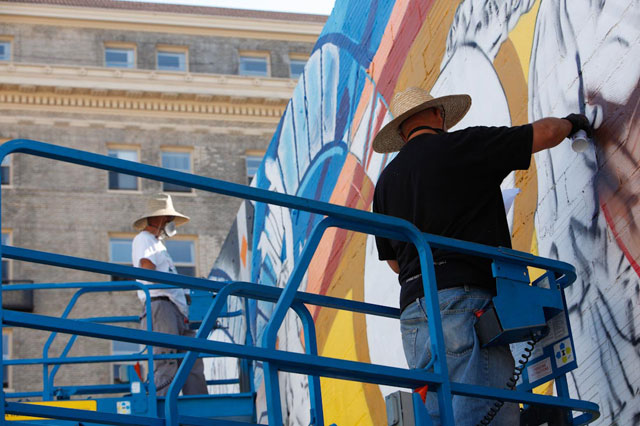
The main artists are Desi Mundo and Pancho Peskador, members of Oakland’s Community Rejuvenation Project (CRP), and they were working on the Alice Street Mural. CRP is a non-profit artist collective motivated by the belief that community-led murals can become fertile meeting grounds for communities.
CRP’s first wall went up in 2008. The group has since produced roughly 150 murals in the Bay Area, almost entirely in Oakland. Now, having worked street level with different neighborhoods all over Oakland, CRP has started what they call a “pavement to policy” initiative advocating for laws and use of public space to better serve the city’s communities. I sat down and spoke with several CRP members over lunch as they were taking a break from working on the mural.
Desi Mundo is the founder of CRP who avoids labels like “street” or “graffiti” artist, opting instead to call himself simply a writer. Originally from Hyde Park, Chicago, Mundo did his first legal wall in 1992, and has done countless more since. Growing up, Mundo loved how writing nourished a hyper-local sense of culture, place, and history, noting that every neighborhood in Chicago had its own distinct style. While Mundo is happy CRP is becoming more socially active, he notes that they still just love to paint. “There is a balance between when we work with the community, and sometimes when we just want to have fun.”
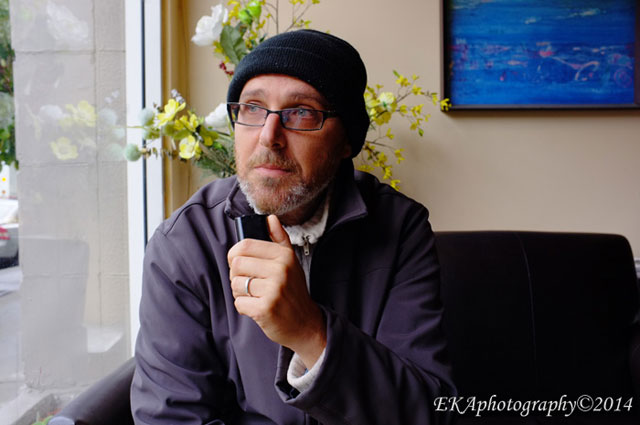
CRP Lead, Pancho Peskador is a trained fine artist from Santiago, Chile where he painted his first mural in high school of Pablo Neruda and other Chilean poets. Peskador came to Oakland in 1995 and was painting alone in his free time as much as possible, until he stumbled upon CRP. “I drove by while they were painting and stopped to talk. Whenever they went to paint I’d just show up.” Peskador writes, “Painting outside, in the street, open-air interaction with the people. After I felt that, it was hard to go back to the studio. I finally had what I was lacking for so long. That community aspect, that collective aspect, but also that interaction with people. Not needing to do a show to hear feedback about your work. So that’s how I started working with CRP.”
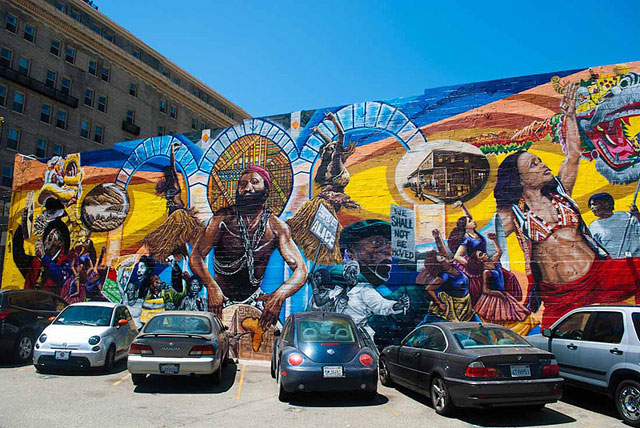
CRP believes that all art — especially mural art — reflects values and culture back to the community. Mundo believes in accepting that responsibility. Consequently, CRP has increasingly incorporated more community involvement into their work. Even though the Alice Street Mural only started going up on the wall recently, community outreach for the mural started over a year ago.
Seeking how to best make a mural for the location, CRP leafleted, interviewed residents, showed up at community events, and more. CRP wanted the people who would be walking by this mural most often to tell them who to feature on the wall. Figuring out how to best represent a community is a huge challenge. “Art has that potential, but it takes a lot of work,” Mundo told me, “these interviews helped transform why I do murals.” Peskador added, “I wanted a mural that honors the people while they are still here.”

The site of the the Alice Street Mural is especially complex because it sits at the intersection of three neighborhoods. It’s just north of Chinatown, east of Oakland’s downtown financial district, and right on the edge of Lakeside, an area of low- and medium-income apartment complexes. With all the diversity and history surrounding the wall, two institutions literally overlooking the site jumped out at CRP: the Malonga Casquelourd Center for the Arts and Hotel Oakland.
Hotel Oakland is an elderly home for mostly monolingual Chinese immigrants, which recently celebrated its 100th anniversary. What excited CRP most about Hotel Oakland is its arts and culture programming where residents teach classes to other residents, mostly on traditional arts and culture from their home town. The Malonga Caquelourd Center for the Arts is a performance and art center. The facility celebrates African diasporic arts, emits constant drumming, hosts dance classes, theater productions, and much more.
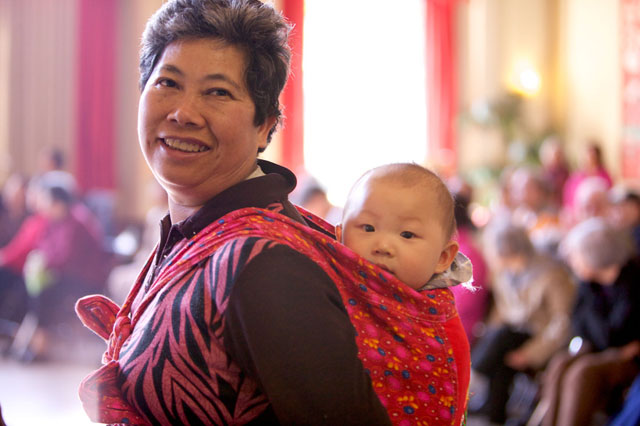
Within these two unique centers CRP found their subjects for the wall, or what Mundo calls “Culture Keepers.” Culture Keepers are the immigrant elders who have maintained and nourished their native cultures even after moving far away and often over long periods of time. They are the folks who pass on traditions and have thus played a key role in shaping the culture of the neighborhood.
Now, the mural has become a part of these residents’ stories and the culture they’ve maintained. But CRP has even bigger plans. Sometime in 2015, the process of creating the mural will become a documentary and website that fills in the stories behind the Alice Street Mural. When someone walks and wonders about the faces on the wall, they can learn more about these characters and discover why they are important to this neighborhood.
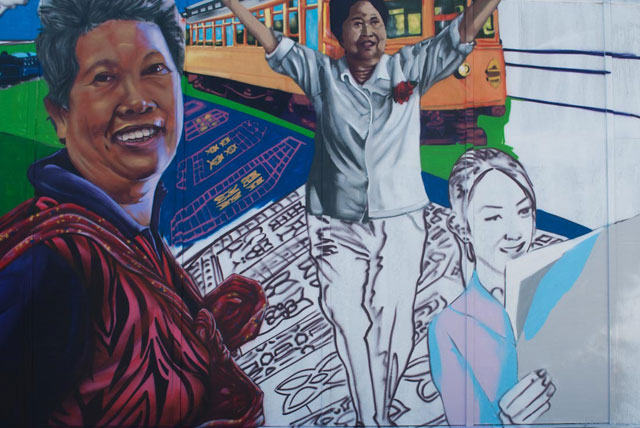
This educational experience is important to CRP, considering the gentrification that is going on throughout the Bay Area. CRP hopes that this mural and the additional documentation can act as a means to nourish respect for the local people and their culture, celebrating what is already here. An art project that beautifies but does not gentrify is a hard balance to walk.
Mundo tells me that CRP’s, “firsthand and on the ground experience helps us educate, promote, and produce better public space.” He wants to use that experience to do more than just murals; he wants to help shape policy around public space and graffiti abatement. Mundo points out that San Francisco spends $24 million and the US spends $17 Billion annually in graffiti abatement, locking up hundreds of youths, mostly people of color. CRP believes that while these policies are trying to help, ultimately they are destructive for the communities and that the price tag is outrageous. Mundo calls it the, “abatement blackhole.”
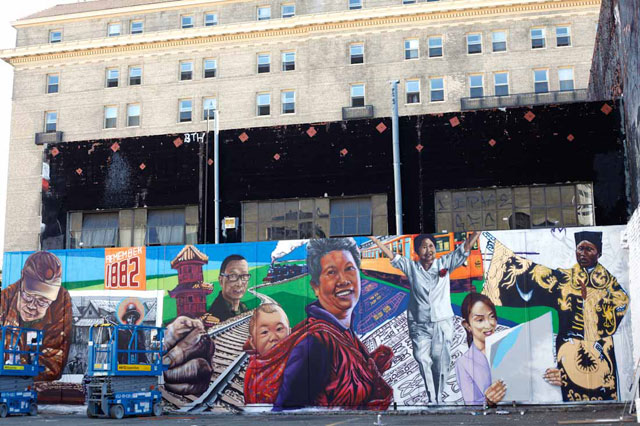
I spoke over the phone about the Alice Street Mural and graffiti abatement in Oakland with Patricia Kernighan, the city council member for Oakland’s District 2. Technically, the mural sits just outside of Kernighan’s district, in Lynette Gibson McElhaney’s District 3. McElhany could not be reached for comment. Kernighan was pleased to see the mural going up in an otherwise graffiti-ridden parking lot, but she does not consider murals a comprehensive solution to Oakland’s graffiti problem. Citing instances where beautiful murals have been tagged over in her district, Kernighan promotes an approach that both supports local art projects like CRP, but also deters offenders.
Meanwhile, CRP firmly believes that giving communities more control over their own walls would be much better for the health and culture of the city. Eric Arnold, Communications Director at CRP says CRP has already done a lot of policy work in the city. “When Oakland proposed an anti-graffiti ordinance last year, we had a lot of concern about that and wanted to make sure there was a restorative justice aspect to it.” CRP helped get the language in the bill changed and the city set aside $400,000 for a public art fund.
Getting a slice of that money to do meaningful projects like the Alice Street Mural, which was funded by the Oakland Cultural Fund and a successful Indiegogo campaign, hasn’t been easy for CRP. Arnold says, “Much of public art used to be funded through the state redevelopment agency, which Jerry Brown eliminated, which has in turn led to a crisis in public art.”
CRP completed the Alice Street Mural August 1, 2014, and invites anyone interested to come and take a look. While many of the faces shown may be unknown to you, hopefully the mural illustrates how important they are to the block. Figuring out how to preserve Oakland’s culture while also keeping it beautiful, safe, and vibrant is a challenge CRP is trying hard to tackle, mural by mural.
Phase 1 Ribbon Cutting ceremony for the Alice Street Mural Project is this Friday, August 8, 3:30pm at 14th and Alice in Oakland. For more information, visit the Facebook event page.